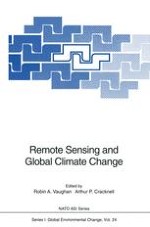1994 | OriginalPaper | Chapter
Basis and Structure of Climate Models
Author : Arthur P Cracknell
Published in: Remote Sensing and Global Climate Change
Publisher: Springer Berlin Heidelberg
Included in: Professional Book Archive
Activate our intelligent search to find suitable subject content or patents.
Select sections of text to find matching patents with Artificial Intelligence. powered by
Select sections of text to find additional relevant content using AI-assisted search. powered by
In Chapter 1 we discussed many natural phenomena and human activities which affect the weather and the climate. It would be an interesting and useful scientific activity if we were able to model the climate, taking into account all the natural phenomena, and predict the future behaviour of the climate in the absence of any effects of human intervention. Given the present public concern, it would be particularly useful if we were then able to model the effects of human activities, as well as the natural phenomena, and make reliable predictions of the effects of human activities on the future climate. Unfortunately, the system is so complicated, our present knowledge is somewhat uneven and our historical knowledge is very little indeed. However, in spite of all the difficulties, a great deal of effort has gone into climate modelling in recent years and some very useful results have been obtained. Given what was said in sections 3 and 4 of chapter 1 about weather forecasting, the difficulties of producing weather forecasts for more than a few days ahead, and the whole idea of chaos versus determinism, it is perhaps both surprising and encouraging that some success in climate modelling can be achieved. There are various books on climate modelling, but the most up-to-date text at present is the volume edited by Trenberth (1992); it contains a comprehensive list of references to earlier work.
